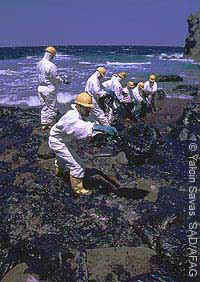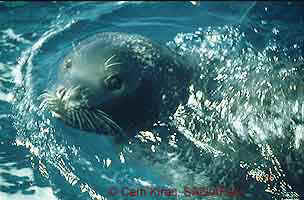 |
|
|
 |
||
OIL SPILL AT ÇAVUS ISLAND
A Clean-up Operation to Save Monk Seal Habitats at Gümüslük, SW Turkey
Cem O. Kiraç

Volunteers struggling with oil sludge at the accident site (© Photo: Yalçin Savas, SAD/AFAG)
 |
|
|
 |
||
OIL SPILL AT ÇAVUS ISLAND
A Clean-up Operation to Save Monk Seal Habitats at Gümüslük, SW Turkey
Cem O. Kiraç

Volunteers struggling with oil sludge at the accident site (© Photo: Yalçin Savas, SAD/AFAG)
Turkish coasts remain one of the last refuges of the endangered Mediterranean seal Monachus monachus. An estimated 50 seals are thought to survive, 32 of which have been individually identified by AFAG (Mediterranean Monk Seal Research Group) and METU-IMS (Middle East Technical University, Institute of Marine Science) during several field research programmes in Turkey (Kiraç et al., 1998). According to Istanbul University studies, 42 individual seals have been identified in Turkish waters (Öztürk, 1995).
The oil spill on the western coasts of Çavus Island was first discovered by AFAG on 22 September 1996, during its UNDP-GEF supported Bodrum research project (Status Survey of Monk Seal Monachus monachus around the Bodrum Peninsula). Subsequently, interviews with local fishermen, the operator of a salvage boat, and other inhabitants, revealed that a Turkish-flagged ship had run aground on Çavus Island during the summer (probably July or August) of 1996.
According to witnesses, the name of the ship was Karaköy-1. Efforts were made to refloat the vessel for two days, during which time oil and sludge was released into the surrounding waters.
The ship’s captain rejected an offer of assistance by the rescue boat ORCAN-1 and insisted on waiting for the rescue vessel of its company in Istanbul, which arrived at the end of the second day and eventually succeeded in refloating the Karaköy-1. This required lifting the nose of ship from the rocks on which it had run aground, a process that resulted in hundreds of tons of oil sludge from the ruptured bow section being discharged into the sea. Despite many witnesses to the incident, including fishermen from Gümüslük, tourists, and the crew of the ORCAN-1, no official complaint to court was registered within 48 hours.
As a result, no legal action could be taken against the Karaköy-1. AFAG contacted the owners of the vessel, a shipping company in Istanbul, to request sponsorship of the clean-up operation, to be performed by SAD-AFAG on a voluntary basis. The company, however, declined to provide any financial assistance.
Description of the Area
Çavus Island is 2 nautical miles west of the Bodrum Peninsula. For reasons still unknown, the ship struck the NW tip of the island and pollution occurred along both the western and north-western coasts, where seal caves are known to exist.
Although Çavus is uninhabited, artisanal fishermen from Gümüslük, Yalikavak and Turgutreis frequently use the coastal waters of the island for fishing during winter, and tour boats ferry day-trippers to the area during the summer season. The western coast of Çavus Island is steep and formed by 30-40 m. high cliffs with 3 sea caves, providing a safe and remote refuge for the area’s monk seals. In contrast, the eastern side of the island is relatively flat, and includes a small, sheltered bay with pebble beach, where tour boats anchor in summer. Tourists generally avoid the less hospitable west coast, where seal caves have been recorded.
Birds observed on or around the island include the Yellow-legged Gull Larus cachinnans, Audouin’s Gull Larus audouinii, Shag Phalacrocorax aristotelis desmarestii and Eleonora’s Falcon Falco eleonorae.
The Importance of Çavus Island to Monk Seals

Monk Seal near Çavus island (© Photo: Cem Kiraç, SAD/AFAG)
Recent studies in the region conducted by the Mediterranean Seal Research Group, AFAG, and others (Berkes, 1982; Marchessaux, 1987 and Öztürk, 1995) since the 1980’s, indicate that the coasts of the Bodrum Peninsula – and particularly its surrounding islands – have long been occupied by monk seals. SAD-AFAG performed cave explorations, observations and information gathering in the region between 1990 and 1997. Seal sightings made directly by AFAG members or recorded during interviews with local fishers were entered into the AFAG FokData database programme. This now incorporates a total of 145 firsthand and reliable seal sighting data along the coasts of the Bodrum Peninsula between 1990 and 1997. During the same period, AFAG made 20 observations of what are thought likely to be 3 different individuals around B.Kiremit and Çavus Islands. As a result of these studies, the seal population in the area is estimated at between 3 and 7 individuals (Kiraç and Veryeri, 1996). A more recent study puts the minimum size of the regional population at 4 individuals, with the majority of all sightings occurring at the following locations (Savas et al., 1998):
|
|
|
|
| Küdür Peninsula |
|
|
| B.Kiremit Island |
|
|
| Çavus Island |
|
|
| Karaada Island |
|
|
| Total |
|
|
In addition, research has indicated that only six suitable seal caves are in use around the entire Bodrum Peninsula, 3 of which exist only at Çavus Island. As such, Çavus Island appears to be one of the three most important monk seal sites in the Bodrum Peninsula, with a relatively high number of seal sightings recorded from the island, including instances of seals observed in groups. In addition, two observations were recorded during the oil spill clean-up operation by AFAG members and the ORCAN-1 crew – a possible indication that seals continue to frequent the western coasts of Çavus.
The Clean-up
Realising the potentially-lethal effects of the oil spill, AFAG wasted no time in alerting relevant government departments and other agencies between September and December 1996. Meanwhile, a sample was taken and submitted to the General Directorate of Environmental Pollution Prevention and Control (ÇEKÖG) of the Ministry of Environment (MoE) in Ankara. Analysis results revealed that the sludge was of typical petrochemical origin, composed of aliphatic and aromatic hydrocarbons. In November, AFAG returned to the pollution site in order to determine whether the oil sludge had spread from the small bay in which it had previously been confined. Fortunately, the spill largely remained in its original dimensions.
Although AFAG had alerted several government agencies to the potentially lethal effects of the oil spill to the Çavus Island monk seals – including the Ministry of Agriculture, the Undersecretary of Maritime and Coast Guard – it soon transpired that there would be no swift government action to clean up the oil spill.
It was for this reason that AFAG decided to take matters into its own hands, launching its Çavus Island Clean-up '97. In order to fund the operation, we first sought finance both in Turkey and abroad. With the assistance of the Seal Rehabilitation and Research Centre (SRRC), Prince Bernhard of the Netherlands was first to respond, with a vital pledge of financial support.
During the same period, the French company le Floch provided supplies of detergents free of charge, most notably the De-Solv-It 1000 brand, which was used effectively in the aftermath of the Exxon Valdez accident. CEDRE (France) and Mykall Industries provided valuable information on oil spill clean-up methodology. BP (Turkey) and other Turkish companies pledged the partial provision of clean-up equipment to the operation. A local organisation, Friends of Bodrum, supported the project by providing their 14 m. steel boat, designed specifically for garbage collection. An award from the Henry Ford Foundation, recognising the merits and importance of the operation, provided additional support. Finally, the required official permission for the operation was obtained from the Turkish Ministry of Environment on 2 April, 1997.
The clean-up was then launched without delay, its objectives being to:
Between April 24 and May 1, 1997, a total of 23 SAD volunteers worked on the western coasts of the Island, and collected approximately 7 tons of floating oil waste. Severe weather conditions, financial constraints, and the time limitations of volunteers forced a premature halt to the clean-up – even though tons of oil sludge remained in the area. In the meantime, however, the clean-up received great attention in the Turkish media, with national TV and mass-circulation newspapers all covering the event.
In order to complete the clean-up, AFAG and Friends of Bodrum issued another appeal to government departments, including the Ministry of Environment and the Bodrum Governor.
It was during the intensive lobbying efforts that followed, that we at last convinced Environment Minister Ms. Imren Aykut to visit Çavus Island to assess first hand the severity of the oil spill. As a result of the trip, the Minister agreed to a budget allocation necessary to complete the clean-up operation.
In September 1997, a private company operating a 30 m. professional salvage boat, ORCAN-1, won the MoE tender and started the clean-up the following month. The Provincial Environment Directorate and SAD-AFAG were appointed as official supervisors, and two AFAG divers joined the ORCAN-1 crew to assist in the clean-up. From 10 October until the end of December 1997, a total of 130 tons of oil sludge was collected from the site and transferred to Turgutreis garbage disposal area. During the final stages of the clean-up, rock surfaces covered by a thin layer of oil were washed by high pressure (200 atm.) steam hoses.
The western coasts of Çavus Island, frequented by the monk seals of the region, have now been returned to their former pristine beauty. To our knowledge, this event may provide a rare illustration of the potential hazards posed by marine pollution to the endangered monk seals.
|
A documentary film entitled Gümüslük, Blue and Black, directed by Yurdakul Kabasakal has been produced by SAD-AFAG. The 30- minute video includes images of monk seals and other wildlife in Turkey. It has been produced in two versions, Turkish and English. Copies are available from SAD/AFAG at $US 35 each, including postage and packing. To order, contact SAD-AFAG by letter, fax or e-mail: SAD/AFAG, PK 420 Yenisehir, 06444 Ankara, Turkey Fax. +90 312 240 9817 E-mail: sadizmir@rocketmail.com Bank transfers should be made to the following account: |
Ackowledgements
This operation could not been realised without the financial support of the Turkish Ministry of Environment. We especially thank the Minister, Ms. Imren Aykut, for her immediate decision to allocate funding to the Çavus Island clean-up. Initial finance from His Royal Highness Prince Bernhard, and the Henry Ford Foundation, also proved invaluable. We also wish to thank Ms. Lenie 't Hart of the SRRC for facilitating AFAG contacts with Prince Bernhard. Ms. Saynur Gelendost of Friends of Bodrum supported AFAG in every respect, especially during discussions with government officials. We also extend our thanks to companies CEDRE and Le Floch for their contributions. Finally, we thank all supporters of the clean-up operation, and in particular, the fishers and other inhabitants of Gümüslük.
References
Berkes F. Monk Seals on the South-west coast of Turkey, Mammals in the Seas, FAO Fisheries Series No.5 Vol. IV, p.237-242. Rome, Italy. 1982.
Kiraç C.O. and Veryeri N.O. Status Survey of the Mediterranean Monk Seal Monachus monachus Around the Bodrum Peninsula, SW Turkey. Research Project Final Report to UNDP-GEF, ISBN 975-6908-00-9, Ankara, December 1996.
Marchessaux D. The Mediterranean Monk Seal in Turkey, Report on a Mission to Turkey for IUCN and UNEP, p.11. IUCN, Gland, Switzerland. 1987
Öztürk B. Akdeniz Foku'nun (Hermann, 1779) Türkiye'de Korunabilmesi için Ulusal Koruma Stratejisinin Uygulanmasi ve Foça Pilot Projesi, TC Çevre Bakanligi Projesi, Proje Sonuç Raporu, 1995.
Savas Y., Kiraç C.O., Veryeri N.O. and Güçlüsoy H. Akdeniz Foku'nun Bodrum Yarimadasi'nda Durumu, Symposium on the Environmental Problems of the Bodrum Peninsula, Bodrum. 15-19 February 1998.
Kiraç C.O., Savas Y., Veryeri N.O. & Güçlüsoy H. Status and Distribution of Mediterranean Seal Along Turkish Coasts, World Marine Mammal Science Conference, Workshop on the Biology and Conservation of the World’s Endangered Monk Seals, Abstracts p.44, 19-20 January 1998.
Copyright © 1998 Cem O. Kiraç. All Rights Reserved